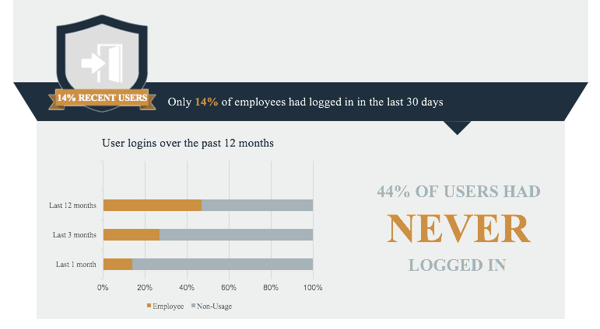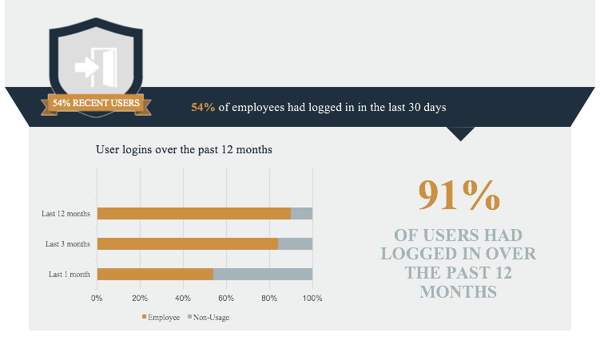Last week I received an email from Apple that annoyed me. I had forgotten to cancel a subscription to an iPhone app that I no longer needed. The cost to me? 99p – about $1.30 – less than a price of a coffee.
Despite the low financial impact, this sort of thing irritates everyone. No-one likes paying for things they don’t use. And yet every day thousands of companies around the world are paying Oracle fees for HR software that are not being adopted by the intended employee and manager audience.
People speak to us because Applaud brings an enhanced user experience and mobile apps to customers’ existing Oracle E-Business Suite (EBS) systems. Part of the business case for investing in Applaud is to increase user adoption – put an improved user experience in front of your workers and more people will use the system.
Why is this worth customers’ budgets?
The cost of software wastage
There are a lot of benefits to increased user adoption – Applaud co-founder Duncan wrote a piece on that here – but one angle we discuss with customers is about reducing ‘software wastage’.
Let’s say your company has approximately 3,000 workers and you paid $100,000 to Oracle 5 years ago for 3,000 Self Service licenses. These licenses allow each of your workers to log in to do basic things like maintain their personal details, book absence, change employment details and so on.
You will have paid annual maintenance of about $20,000 per year, so total spend to date would be $200,000.
When that purchase was first made, you would have had a business case to justify the spend. Items like process efficiencies and reducing HR Administration costs would have formed the basis of that case.
Now let’s say only 50% of your workers rarely log on and use the system. Straight away, you’ve spent $100,000 on software that’s not being used. The business case is only partially realised.
It gets worse when you look at annual support. Every year, you’ll pay $20,000 maintenance fees to Oracle. Half of those fees are to support the users that never log on. $10,000 spent a year for nothing.
These figures might not seem like much but they get much more interesting when:
- Your company size is larger than 3,000 workers
- Your user adoption is lower than 50%.
We embarked on some analysis with existing and new customers to look at their adoption of Oracle EBS Self Service. The results were surprising.
Worker adoption when using standard Oracle
We surveyed a variety of customers that were still using the standard Oracle Self Service user experience with no mobile access. The company sizes varied between 500 workers and 100,000, so a nice blend of large and small customers were checked.
The averages across these customers were as follows:
- Employees logging in during past month: 14%
- Last 3 months: 27%
- Last 12 months: 47%
- Never logged in once: 44%

So, for an average Oracle E-Business Suite customer, over half of the workforce do not log in at all over a 12 month period. We also found that for customers with a better usage rate than this there was often an annual event like open enrolment or performance reviews that forced workers to log in and use the system about once per year and then ignore it the rest of the year.
The monthly average login is shockingly low; verging on only 10% of workers using the system on a regular basis.
What was even more surprising was the number of employees that never log in even once to Self Service – almost half. How do these employees book vacations or managers update salaries? Presumably employees work locally with their managers to get time off and managers call into HR to get details updated. It all defeats the object of investing in Self Service in the first place.
At $40 list price for Oracle Self Service, plus annual maintenance, that’s a lot of dollars to spend on zero use.
What’s the cost?
The amount you’ve paid for unused software will, of course, vary by the amount of software procured and the larger the customer, the more pronounced the figures. We found one customer at the upper end would have spent in excess of $1.5 million on Self Service licenses that had never been used. They are also paying approximately $120,000 year on year support fees to Oracle in support of those unused licenses.
Once you have your own user adoption statistics and can find out what you are paying Oracle annually for support, it’s a fairly easy to calculate how much low usage is costing you.
What happens when user experience is improved?
We performed the same audit on customers that had implemented Applaud and improved the user experience of their Oracle E-Business Suite system. The average results across these customers surprised even us:
- Employees logging in during past month: 54%
- Last 3 months: 84%
- Last 12 months: 90%
- Never logged in once: 9%

Their statistics shows that customers using Applaud have tripled the monthly user adoption over the average customer running standard Oracle. In terms of users never logging in, the number is small enough that the system can be considered as fully utilized.
So what’s the user adoption like for you?
Not many people like paying Oracle annual maintenance but the blow is softened when you are paying for something that is actually in use. We have found that improving the user experience offers the biggest step forward in adoption and completes your original business case for Self Service. Even better, deploying Applaud is usually a ‘quick win’; something that can be achieved in a few months without the need of a time consuming and expensive program of change.
If you are interested in finding out your own user adoption statistics on Oracle E-Business Suite, we can provide you with the scripts to run your own health check. We need no access and the checks take a few minutes to execute.
And, unlike Oracle’s software and support, the health check is free.
If you’d like to reduce your software wastage, get in touch.




-1.png?width=420&height=134&name=applaud_award_logos_aug2021_img%20(1)-1.png)